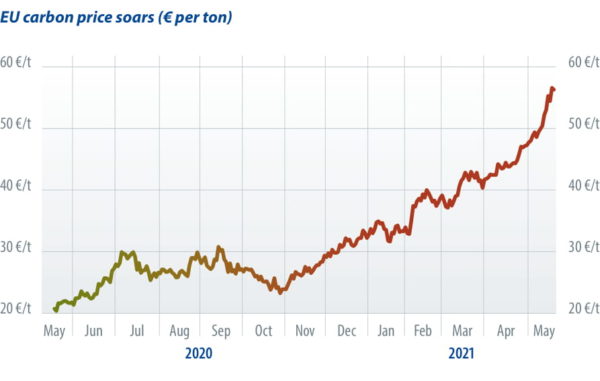From pv magazine 06/2021
The Revised Renewables Directive (RED lll) under the “Fit for 55” package, set for release in July 2021, is expected to see the 2030 renewables target increased to at least 38% to 40% in final energy consumption, up from 32% currently. This is to better align the target with the EU’s goal of reducing greenhouse gas (GHG) emissions by 55% by 2030 compared with 1990 levels, up from the previous 40% target. At first glance, a revised 2030 target seems to be a significant boost for solar power and other renewable energy. The EU’s 20% by 2020 renewables target, for example, was instrumental in getting renewables projects off the ground.
“A 38% to 40% renewables target by 2030 would be significant. The target will support further growth in solar auctions and PPAs also in emerging markets such as Bulgaria, Croatia, Romania and Hungary. But power is the easy bit – the new target should also support decarbonization of the heating, cooling and transport sectors,” Coralie Laurencin, senior director for European power, renewables and climate at IHS Markit told pv magazine.
The 20% by 2020 target was binding and broken down to national targets depending on member states’ starting point and renewable resources. The 2030 target, on the other hand, is an EU-wide target and is not legally binding. Yet many think this softer regime will be enough to support growth at least in mature renewables technologies.
“I do not think it is a big issue for solar PV that the target is not legally binding for member states. Solar faces a lot fewer hurdles than wind when it comes to planning permission and public opposition. And governments are very much aware of that,” said Laurencin.
Some say even a 40% renewables target may be too modest to align with the 55% GHG target for 2030 and the 2050 net-zero target. WWF, for example, is calling for a 50% target, while SolarPower Europe is calling for an even higher 55%. Yet an overall 38% to 40% target would likely mean doubling the share of renewable generation.
“(A) 38% to 40% renewables is a significant increase to the current levels, especially as 2030 is only nine years away. I think we may see more regional cooperation, such as statistical transfers and joint projects, to attract foreign investment,” Dalia Majumder-Russell, a partner in the energy, projects and construction team at law firm CMS, told pv magazine. “There is a lot of goodwill towards renewables at the political level and solar stands to benefit because it is an established technology with a relatively well understood regulatory framework.”
Carbon price rally
The July package will include a number of other legislations that are relevant for the PV industry. Further reform of the EU’s Emissions Trading System (EU ETS), for example, could support a continuation of the price rally witnessed in recent months. EU carbon prices have risen to unprecedented levels despite the Covid-19 pandemic and lower demand for energy. The Benchmark DEC 21 contract closed above €56/ton on the ICE exchange on Friday 14 May, up from around €20/ton the same time last year.
The price rally has been driven by regulatory reforms and the decision by the EU institutions to limit the supply of allowances and take credits out of the market if the number reaches certain thresholds, also known as the Market Stability Reserve. The bull run in carbon prices has led to a sharp reduction of coal-fired power generation across Europe, much to the advantage of solar and wind. Even older gas-fired plants may struggle to be profitable if carbon prices continue to rise.
Coal-fired generation decreased by 20% year on year in the 27 EU countries in 2020, according to data from the European Commission and Agora Energiewende. At the same time, generation from solar installations increased by 15%.
The July package will include a proposal to further limit the supply of allowances – the linear reduction factor – and possibly to include the shipping sector under the ETS. The latter could bolster demand for allowances further. Including shipping under ETS has support from the European Parliament, but the question is if member states will also come onboard.
“The solar industry is not shielded from ETS reform as higher carbon prices could affect the supply and cost of materials. But the EU ETS needs reform if governments are to meet their net zero aims. Higher carbon prices are helpful for changing investors’ mindsets. Including shipping is a good idea, but it will be difficult as it is a very international industry with many stakeholder interests to manage,” said Majumder-Russell.

Rebuilding buildings
Brussels may also table a separate ETS for transportation and buildings. The Energy Performance in Buildings Directive is also up for review this summer, and more ambitious targets for lower energy consumption are expected. That would be a boost for solar panel installations in buildings, for example.
The building sector is one of the largest energy consumers in Europe, accounting for around 40% of energy demand. Many of Europe’s ageing and inefficient buildings rely on fossil fuels for heating and cooling. But the EU’s €672.5 billion post-Covid-19 recovery package could help accelerate the renovation of buildings. Support will also come from the European Structural and Investment Funds and from the European Fund for Strategic Investment, according to European energy commissioner Kadri Simson.
“In the next few years, we are going to see funds from multiple sources pouring into building renovation,” Simson said in a recent speech.
Green hydrogen
The EU Gas Directive is outdated and a new proposal is expected in the fourth quarter of this year. The revised directive aims to outline how transportation networks for green hydrogen will be operated, and will set rules for retrofitting existing gas networks as well as gas blending. This is key for the scaling up of green hydrogen projects.
One of the main sticking points is if transmission system operators (TSOs) should be allowed to own and operate electrolysis facilities converting water to hydrogen using renewable energy. The unbundling obligation under the current gas package – which came into effect in 2012 – states that companies cannot operate production, supply, and transmission assets as a vertically integrated business. This is to avoid conflict of interests by restricting competitors’ access to pipelines, for example.
A stakeholder consultation revealed that many energy companies want the principles under the existing gas package to be transferred to the hydrogen sector. For example, solar power producers should get fair access to electrolyzer capacity if they want to convert the electricity and ship it to customers in the form of hydrogen or otherwise.
“This package should reinforce the key principles of liberalization,” said E.On in its reply to the stakeholder consultation. “Regarding unbundling, it should be made clear that emerging technologies such as electrolyzers are not natural monopolies and, hence, cannot be owned or controlled by TSOs/DSOs.”
A number of energy companies have also called on the commission to set specific targets for renewable gases – for example, 11% of European gas demand by 2030 as proposed by Eurogas. Many stakeholders – EDF, Engie, Shell and Total among them – also support an EU-wide market for tradable Guarantees of Origin for low-carbon gases and electricity. Such measures may fall under the scope of both RED lll and the Gas Package. The stakeholder consultation for the Gas Package closes on June 18.
This content is protected by copyright and may not be reused. If you want to cooperate with us and would like to reuse some of our content, please contact: editors@pv-magazine.com.



4 comments
By submitting this form you agree to pv magazine using your data for the purposes of publishing your comment.
Your personal data will only be disclosed or otherwise transmitted to third parties for the purposes of spam filtering or if this is necessary for technical maintenance of the website. Any other transfer to third parties will not take place unless this is justified on the basis of applicable data protection regulations or if pv magazine is legally obliged to do so.
You may revoke this consent at any time with effect for the future, in which case your personal data will be deleted immediately. Otherwise, your data will be deleted if pv magazine has processed your request or the purpose of data storage is fulfilled.
Further information on data privacy can be found in our Data Protection Policy.